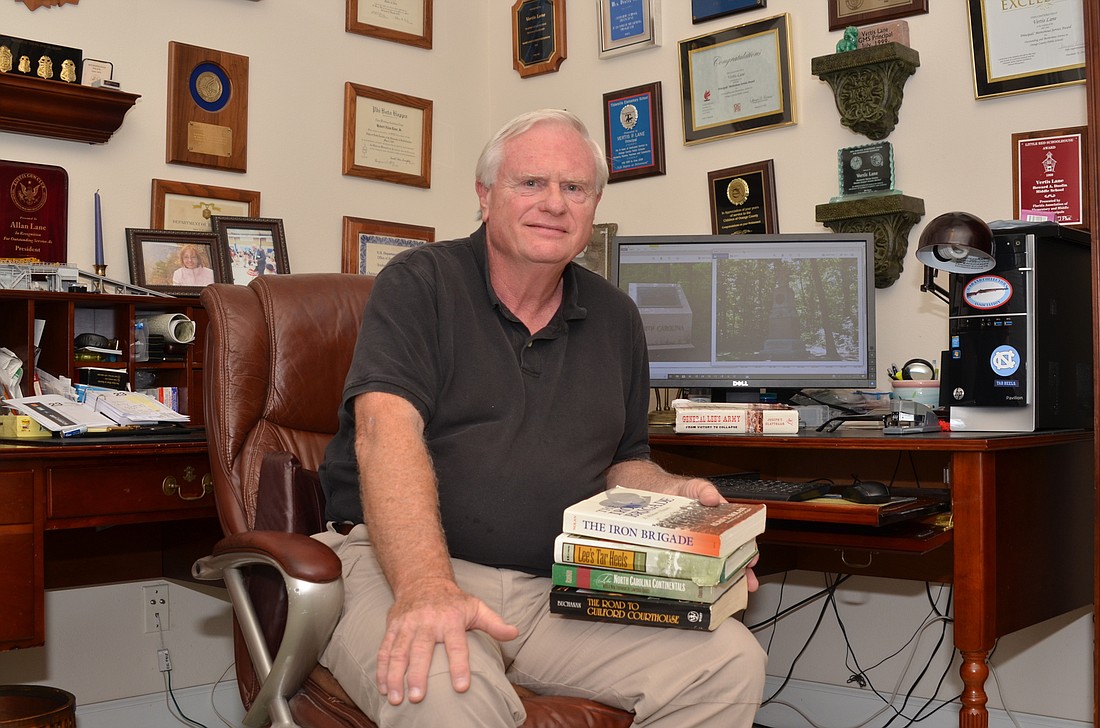- January 1, 2025
-
-
Loading

Loading

Allan Lane’s fascination with Gettysburg began long before he even learned that he had an ancestor who fought in the Civil War. When his high school history teacher asked the students to give 15-minute presentations, Lane picked the Battle at Gettysburg, fought over three days in July 1963 in and around the Pennsylvania town.
“I’ve always been interested in history,” said Lane, a Winter Garden resident. “It’s always been a passion. As I’ve grown older and I’ve had more time, I could really devote myself to it. I always loved American history, world history, European history. I’ve been a pretty good reader all my life.”
Fast-forward to 1981, when Lane asked his father for any family information he had. Lane was told to contact a distant cousin, who had done some family research, and this cousin provided a great deal of information.
“This was long before the internet age, and there wasn’t a lot I could do with it,” said Lane, who, at the time, was an agent with the Federal Bureau of Investigation. “I couldn’t just take three months off my job and travel around to courthouses.”
His interest was piqued again when he worked as an investigator for a law firm and was tasked with doing historical research on families who had land in Florida. He opened an account with the genealogy website Ancestry.com and ultimately became interested in his own family.
Lane now is retired, so he has time to devote to his passions: history, ancestry and reading.
BATTLE LINES
Lane has read over thousands of military records, transcripts, court documents and old maps to piece together the details of his ancestors’ stories during the Revolutionary and Civil wars. The history buff shares these stories at a genealogy club and through a speakers bureau within the Sons of the American Revolution organization.
The SAR’s mission is to preserve and share American history and promote patriotism. As president of the Lake-Sumter Chapter, Lane’s goal is to get more people interested in the details of America’s history.
Lane has five different talks: two on the Revolutionary War; two on the Civil War; and one on the War of the Regulation — all of which include either stories about his native state of North Carolina or his or his wife Vertis’ ancestors.
The War of the Regulation ended with the Battle of Alamance, an uprising in the Carolina colonies in which about 2,000 farmers, angry over excessive land taxes and land seizures, violently took on reportedly corrupt Colonial officials.
Lane said his fifth-great-grandfather was one of those farmers who took over the town of Hillsborough, North Carolina, destroyed court documents, tied up and beat the sheriff and used a team of horses and mules to pull down the sheriff’s house. The grandfather, James Emerson, was one of only six who received a reprieve.
“He signed an oath and returned to his life as a farmer,” Lane said.
This battle ended five years before the Revolutionary War began.
Vertis Lane’s fifth-great grandfather was a soldier in the Revolutionary War’s Battle of Waxhaws. His story is documented in a pension application filed in 1812, Allan Lane said.
“Private Thomas Pearson, of the Continental Army’s Virginia Line, was wounded severely and somehow escaped and survived,” Lane said. “He had sword wounds to the head.”
The ancestral story of Gettysburg is Lane’s favorite to tell. The story comes full circle when 150 years after the battle he stood at the very site on which his maternal great-great-grandfather likely fought.
Private Charles Moody was in the Confederate Army’s North Carolina 26th Regiment in 1863. The battle had already begun at Gettysburg on the morning of July 1 as the soldiers marched closer. When they crossed a stream at Gettysburg called Willoughby Run, they engaged in a hard-fought battle with an opposing regiment.
“They stood face to face and basically slaughtered each other,” Lane said.
His grandfather was wounded in the left arm and both legs, which put him out of the battle, but he survived the war, Lane said. According to records, Moody recovered at a temporary hospital in Staunton, Virginia.
In his research, Lane discovered a transcription of a speech the North Carolina 26th commander gave at the 40th anniversary of the Battle of Gettysburg. The commander described in detail what happened to his regiment that day and said the men got entangled in thorny brambles at the side of the ridge and were gunned down.
In 2013, Lane and his younger son went on a trip to Gettysburg.
“I also hired a licensed battlefield guide to search and guide me through the regiment movement on that day,” he said. “He showed me where the center of the line was — there’s two monuments there. … The next day, we crossed over Willoughby Run and went down about 50 yards where we believe the center of the line was.
“We started across and up the hill — and we had to stop because there were thorny brambles,” he said. “They were still there.”
SEARCHING RECORDS
To become a member of the Sons of the American Revolution, or its counterpart, the Daughters of the American Revolution, one has to show proof of a direct bloodline to a patriot — either a soldier or someone who provided goods to the states to help establish independence.
After much research, Lane discovered a patriot in his family tree: Isham Lane.
Allan Lane suggests folks looking for records to verify military service go to the Fold3 website, which has all of the National Archives Civil War records and many Revolutionary War records, he said.
“Once you get into that and figure out how the records are established, you find a lot of records that you hadn’t considered.”